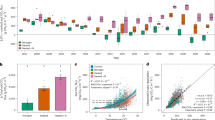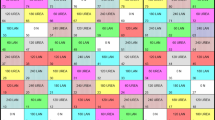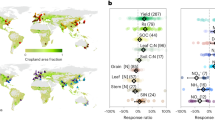Abstract
Humans have increased atmospheric carbon dioxide (CO2), causing major changes in global climate while concurrently increasing the supply of biologically limiting nutrients especially nitrogen (N). Despite myriad negative effects on ecosystems and human health, nutrient pollution can increase the storage of soil carbon (C) in grasslands and retired farmland, potentially reducing atmospheric CO2. However, the persistence of nutrient-induced soil carbon gains remains a knowledge gap at the heart of a potential policy dilemma: whether reducing nutrient pollution could lead to the release of soil carbon that accumulated under high nutrient supply. Here we use a four-decade experiment conducted on retired, marginal cropland to demonstrate that nutrient addition increased soil C storage after intensive tilling, and that these soil C gains persisted for at least three decades following fertilizer and tilling cessation. This occurred despite plant biomass rapidly returning to pre-fertilization levels and plant community composition recovering from the effects of fertilization. These results demonstrate that nutrient-induced increases in soil C can persist for decades following reduced nutrient pollution as long as the soil remains untilled.
This is a preview of subscription content, access via your institution
Access options
Access Nature and 54 other Nature Portfolio journals
Get Nature+, our best-value online-access subscription
$32.99 / 30 days
cancel any time
Subscribe to this journal
Receive 12 print issues and online access
$259.00 per year
only $21.58 per issue
Buy this article
- Purchase on SpringerLink
- Instant access to full article PDF
Prices may be subject to local taxes which are calculated during checkout





Similar content being viewed by others
Data availability
All data are available via the Environmental Data Initiative data repository at https://doi.org/10.6073/pasta/10dfeaaf9068e99246ca8b6c4ad14c50 (ref. 58), https://doi.org/10.6073/pasta/b7bc6704f9b15fcd29842fa23c96f314 (ref. 59) and https://doi.org/10.6073/pasta/f2ab91096cb3bb672182ba091cb467c1 (ref. 60).
References
Bai, Y. F. & Cotrufo, M. F. Grassland soil carbon sequestration: current understanding, challenges, and solutions. Science 377, 603–608 (2022).
Bossio, D. A. et al. The role of soil carbon in natural climate solutions. Nat. Sustain. 3, 391–398 (2020).
Lal, R. Soil carbon dynamics in cropland and rangeland. Environ. Pollut. 116, 353–362 (2002).
McLauchlan, K. The nature and longevity of agricultural impacts on soil carbon and nutrients: a review. Ecosystems 9, 1364–1382 (2006).
Watson, R. T. et al. Land Use, Land-Use Change, and Forestry. A Special Report of the IPCC, Intergovernmental Panel on Climate Change (Cambridge Univ. Press, 2000).
Schuman, G. E., Janzen, H. H. & Herrick, J. E. Soil carbon dynamics and potential carbon sequestration by rangelands. Environ. Pollut. 116, 391–396 (2002).
Hungate, B. A. et al. The economic value of grassland species for carbon storage. Sci. Adv. 3, e1601880 (2017).
Drever, C. R. et al. Natural climate solutions for Canada. Sci. Adv. 7, eabd6034 (2021).
Ellis, P. W. et al. The principles of natural climate solutions. Nat. Commun. 15, 547 (2024).
Fay, P. A. et al. Grassland productivity limited by multiple nutrients. Nat. Plants 1, 15080 (2015).
Fornara, D. A. & Tilman, D. Soil carbon sequestration in prairie grasslands increased by chronic nitrogen addition. Ecology 93, 2030–2036 (2012).
Tjoelker, M. G., Craine, J. M., Wedin, D., Reich, P. B. & Tilman, D. Linking leaf and root trait syndromes among 39 grassland and savannah species. N. Phytol. 167, 493–508 (2005).
Gill, A. L. et al. Nitrogen increases early-stage and slows late-stage decomposition across diverse grasslands. J. Ecol. 110, 1376–1389 (2022).
Gill, A. L., Schilling, J. & Hobbie, S. E. Experimental nitrogen fertilisation globally accelerates, then slows decomposition of leaf litter. Ecol. Lett. 24, 802–811 (2021).
Lugato, E., Leip, A. & Jones, A. Mitigation potential of soil carbon management overestimated by neglecting N2O emissions. Nat. Clim. Change 8, 219–223 (2018).
van Groenigen, J. W. et al. Sequestering soil organic carbon: a nitrogen dilemma. Environ. Sci. Technol. 51, 4738–4739 (2017).
Schlesinger, W. H. On the fate of anthropogenic nitrogen. Proc. Natl Acad. Sci. USA 106, 203–208 (2009).
Climate Change 2022: Mitigation of Climate Change. Contribution of Working Group III to the Sixth Assessment Report of the Intergovernmental Panel on Climate Change (IPCC, 2022).
Climate Change 2014: Synthesis Report. Contribution of Working Groups I, II and III to the Fifth Assessment Report of the Intergovernmental Panel on Climate Change (IPCC, 2014).
Midolo, G. et al. Impacts of nitrogen addition on plant species richness and abundance: a global meta-analysis. Glob. Ecol. Biogeogr. 28, 398–413 (2019).
Seabloom, E. W. et al. Plant species’ origin predicts dominance and response to nutrient enrichment and herbivores in global grasslands. Nat. Commun. 6, 7710 (2015).
Bharath, S. et al. Nutrient addition increases grassland sensitivity to droughts. Ecology 101, e02981 (2020).
Seabloom, E. W., Borer, E. T., Hobbie, S. E. & MacDougall, A. S. Soil nutrients increase long-term soil carbon gains threefold on retired farmland. Glob. Change Biol. 27, 4909–4920 (2021).
Luo, X. Z., Zhang, L. L., Lin, Y. B., Wen, D. Z. & Hou, E. Q. Nitrogen availability mediates soil organic carbon cycling in response to phosphorus supply: a global meta-analysis. Soil Biol. Biochem. 185, 8 (2023).
Schlesinger, W. H. Carbon sequestration in soils. Science 284, 2095 (1999).
Zis, T. P. V. & Cullinane, K. The desulphurisation of shipping: past, present and the future under a global cap. Transp. Res. Part D 82, 15 (2020).
Yuan, T. et al. Abrupt reduction in shipping emission as an inadvertent geoengineering termination shock produces substantial radiative warming. Commun. Earth Environ. 5, 281 (2024).
van Dijk, M., Morley, T., Rau, M. L. & Saghai, Y. A meta-analysis of projected global food demand and population at risk of hunger for the period 2010–2050. Nat. Food 2, 494–501 (2021).
Pörtner, H.-O. et al. Scientific outcome of the IPBES-IPCC co-sponsored workshop report on biodiversity and climate change. Zenodo https://doi.org/10.5281/zenodo.4782538 (2021).
Huang, J. & Hartemink, A. E. Soil and environmental issues in sandy soils. Earth Sci. Rev. 208, 103295 (2020).
Liu, S. et al. The Unified North American Soil Map and its implication on the soil organic carbon stock in North America. Biogeosciences 10, 2915–2930 (2013).
Plantinga, A. J. The effect of agricultural policies on land use and environmental quality. Am. J. Agric. Econ. 78, 1082–1091 (1996).
O’Halloran, L. R. et al. Regional contingencies in the relationship between aboveground biomass and litter in the world’s grasslands. PLoS ONE 8, e54988 (2013).
Olson, J. S. Energy storage and the balance of producers and decomposers in ecological systems. Ecology 44, 322–331 (1963).
Hobbie, S. E. Plant species effects on nutrient cycling: revisiting litter feedbacks. Trends Ecol. Evol. 30, 357–363 (2015).
Dijkstra, F. A., Hobbie, S. E., Knops, J. M. H. & Reich, P. B. Nitrogen deposition and plant species interact to influence soil carbon stabilization. Ecol. Lett. 7, 1192–1198 (2004).
Peng, Y. F. et al. Nonlinear response of soil respiration to increasing nitrogen additions in a Tibetan alpine steppe. Environ. Res. Lett. 12, 11 (2017).
Prager, C. M. et al. A gradient of nutrient enrichment reveals nonlinear impacts of fertilization on Arctic plant diversity and ecosystem function. Ecol. Evol. 7, 2449–2460 (2017).
Wilcots, M. E. et al. Realistic rates of nitrogen addition increase carbon flux rates but do not change soil carbon stocks in a temperate grassland. Glob. Change Biol. 28, 4819–4831 (2022).
NRCS. Official Soil Series Descriptions (2025).
Grigal, D. F., Chamberlln, L. M., Wroblewski, D. V. & Gross, E. R. Soils of the Cedar Creek Natural History Area (Univ. Minnesota, 1974).
Lloret, J. & Valiela, I. Unprecedented decrease in deposition of nitrogen oxides over North America: the relative effects of emission controls and prevailing air-mass trajectories. Biogeochemistry 129, 165–180 (2016).
Seabloom, E. W., Borer, E. T. & Tilman, D. Grassland ecosystem recovery after soil disturbance depends on nutrient supply rate. Ecol. Lett. 23, 1756–1765 (2020).
Hassink, J. Effects of soil texture and structure on carbon and nitrogen minerlatization in grassland soils. Biol. Fertil. Soils 14, 126–134 (1992).
Kristensen, H. L., McCarty, G. W. & Meisinger, J. J. Effects of soil structure disturbance on mineralization of organic soil nitrogen. Soil Sci. Soc. Am. J. 64, 371–378 (2000).
Keller, A. B. et al. Soil carbon stocks in temperate grasslands differ strongly across sites but are insensitive to decade-long fertilization. Glob. Change Biol. 28, 1659–1677 (2022).
Shabtai, I. A. et al. Calcium promotes persistent soil organic matter by altering microbial transformation of plant litter. Nat. Commun. 14, 13 (2023).
Huang, X. L. et al. Ten-year long-term organic fertilization enhances carbon sequestration and calcium-mediated stabilization of aggregate-associated organic carbon in a reclaimed Cambisol. Geoderma 355, 11 (2019).
Khan, S. A., Mulvaney, R. L., Ellsworth, T. R. & Boast, C. W. The myth of nitrogen fertilization for soil carbon sequestration. J. Environ. Qual. 36, 1821–1832 (2007).
Vandever, M. W. et al. Persistence and quality of vegetation cover in expired Conservation Reserve Program fields. Ecosphere 14, 13 (2023).
Ackerman, D., Millet, D. B. & Chen, X. Global estimates of ionorganic nitrogen deposition across four decades. Glob. Biogeochem. Cycles 33, 100–107 (2019).
NRCS. Web Soil Survey (2024).
Knops, J. M. H. & Tilman, D. Dynamics of soil nitrogen and carbon accumulation for 61 years after agricultural abandonment. Ecology 81, 88–98 (2000).
Adalibieke, W., Cui, X., Cai, H., You, L. & Zhou, F. Global crop-specific nitrogen fertilization dataset in 1961–2020. Sci. Data 10, 617 (2023).
Tilman, D. Secondary succession and the pattern of plant dominance along experimental nitrogen gradients. Ecol. Monogr. 57, 189–214 (1987).
Balesdent, J. et al. Atmosphere–soil carbon transfer as a function of soil depth. Nature 559, 599–602 (2018).
Dijkstra, F. A., Hobbie, S. E. & Reich, P. B. Soil processes affected by sixteen grassland species grown under different environmental conditions. Soil Sci. Soc. Am. J. 70, 770–777 (2006).
Tilman, D. Soil carbon: long-term nitrogen deposition during grassland succession. EDI https://doi.org/10.6073/pasta/10dfeaaf9068e99246ca8b6c4ad14c50 (2024).
Tilman, D. Soil nitrogen: long-term nitrogen deposition during grassland succession. EDI https://doi.org/10.6073/pasta/b7bc6704f9b15fcd29842fa23c96f314 (2024).
Tilman, D. Plant aboveground biomass data: long-term nitrogen deposition during grassland succession. EDI https://doi.org/10.6073/pasta/f2ab91096cb3bb672182ba091cb467c1 (2024).
Acknowledgements
We thank the staff, scientists and interns at Cedar Creek who have participated in this work over the decades. This work was supported by grants from the US National Science Foundation Long-Term Ecological Research Program (LTER) including DEB-1234162 and DEB-1831944. Support also was provided by the Cedar Creek Ecosystem Science Reserve and the University of Minnesota.
Author information
Authors and Affiliations
Contributions
E.W.S. wrote the paper, with contributions from S.E.H., A.S.M. and E.T.B. E.W.S. analysed the data.
Corresponding author
Ethics declarations
Competing interests
The authors declare no competing interests.
Peer review
Peer review information
Nature Geoscience thanks Enqing Hou and the other, anonymous, reviewer(s) for their contribution to the peer review of this work. Primary Handling Editors: Xujia Jiang and Carolina Ortiz Guerrero, in collaboration with the Nature Geoscience team.
Additional information
Publisher’s note Springer Nature remains neutral with regard to jurisdictional claims in published maps and institutional affiliations.
Supplementary information
Supplementary Information
Supplementary Figs. 1–4 and Tables 1–6
Rights and permissions
Springer Nature or its licensor (e.g. a society or other partner) holds exclusive rights to this article under a publishing agreement with the author(s) or other rightsholder(s); author self-archiving of the accepted manuscript version of this article is solely governed by the terms of such publishing agreement and applicable law.
About this article
Cite this article
Seabloom, E.W., Hobbie, S.E., MacDougall, A.S. et al. Multidecadal persistence of soil carbon gains on retired cropland following fertilizer cessation. Nat. Geosci. 18, 1014–1019 (2025). https://doi.org/10.1038/s41561-025-01801-5
Received:
Accepted:
Published:
Issue date:
DOI: https://doi.org/10.1038/s41561-025-01801-5



